The Lowcountry has a longstanding reputation for amazing food, hospitality, and historic ambiance and to this day, there is no shortage of Charleston fine dining restaurants for that special occasion or to share the city’s best with visiting friends. Husk, Muse, Zero George, and Circa 1886 are in adaptively used historic residences and carriage houses, where guests are seated in formal dining rooms and parlors, while Hall’s, High Cotton, and Peninsula Grill are located in spacious historic commercial buildings recalling the city’s nineteenth century heyday. Topsail and the Old Post Office greet Mount Pleasant diners, and there is a new Hall’s for Summerville residents in Nexton community.
Charleston has always had inns and hotels for weary travelers, which typically offered food and a tavern, but it wasn’t until the antebellum era that travelers could expect formal dining and fine meals. Prior to that, grand meals were typically found in private residences when the owners entertained, and they often had caterers and chefs on hand to provide multi-course, complicated meals. Hotel restaurants of the antebellum era offered similar fare to fine private dining: turtle soup, steaks, fresh seafoods with fine sauces.
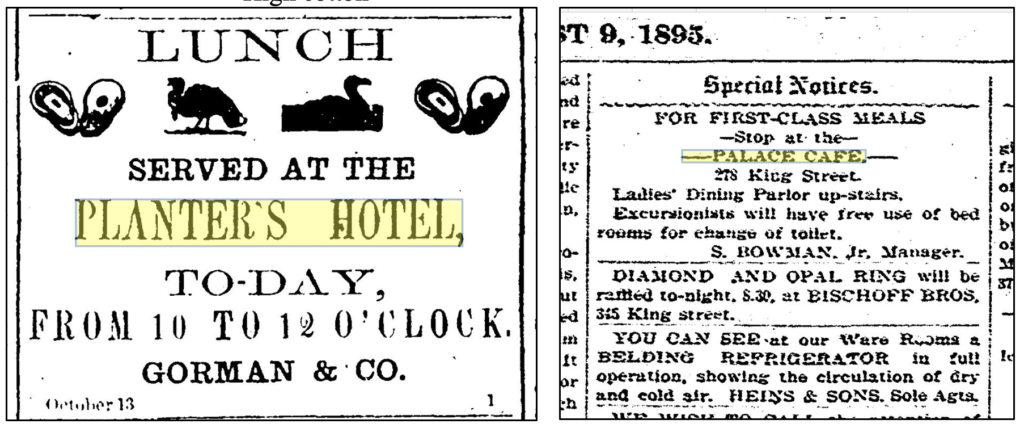
One of the most sought-after chefs was Nat Fuller, who was born a slave and who owned his own restaurant after the American Civil War, where he catered to Charleston elites, but in his own establishment and on his own terms. His restaurant was called the Bachelor’s Retreat, where Fuller offered fish, poultry, and meat courses. An 1863 ad noted, “an excellent breakfast can always be obtained at Bachelor’s Retreat, corner of Church Street and St. Michael’s Alley. A good lunch and oysters constantly on hand. Everything will be served up in the best style directly from the heating furnaces, and worthy of the reputation of the Retreat.”
The Palace Café near King and Market Street was all the rage with wealthy northern travelers at the turn of the twentieth century (rice fed Georgetown duck was the specialty). In those days, the local custom was to serve the largest meal of the day at 3pm, which the downtown restaurants honored. An 1895 article in the News and Courier speaks to early restaurant culture in Charleston: “Bowman’s Palace Café- a restaurant where ladies may be accommodated. Charleston has long needed a first-class restaurant. The ladies particularly were the greatest sufferers, for there was no first-class establishment where a man could take his wife, sister, or sweetheart for a lunch of meal. The men could drop anywhere and get a beefsteak or sandwich, but there was no place to take the ladies. This has been remedied now, at the Bowman’s Palace Café. Upstairs there are two handsomely fitted rooms, exquisitely finished, with walls done in paper mache. Electric fans cool the air, and eclectic bells are handy to call the waiters.”

Fast forwarding to Charleston today, there ar several award -winning restaurants that pay homage to Charleston’s fine dining heritage. High Cotton opened in 1999 in a historic shop front on East Bay Street that was once across the street from bustling wharves and factor’s offices. Most of the block was revitalized as part of the Lodge Alley redevelopment project, a pioneering attempt to turn several lovely but derelict warehouses and shops into a new hospitality district. Heart pine floors and exposed original brick provide a warm backdrop for lively conversation and traditional southern fare. They offer shrimp cocktail, seafood bouillabaisse, lobster tail in truffle butter, crab cakes, rack of lamb that would be at home on a historic fine dining Charleston menu.
Zero George is a luxurious boutique hotel located in the Benjamin Dupree house, a fine cypress framed house on a full masonry raised basement, constructed in 1805. The house has delicate Federal era details and wide south facing piazzas, which now offer outdoor restaurant seating to compliment the indoor dining rooms (in the original dining rooms and parlors of the historic house.) The restaurant “puts the focus on hyper-seasonal fare, including herbs and vegetables from our own garden. Local fishermen keep us stocked with the freshest seafood, while our farm partners continually amaze us with Lowcountry bounty.” They offer a small cooking school, a prix fixe pre-Symphony dinner menu during the season, and a year-round, ever changing chef’s tasting menu with wine parings. A recent tasting menu included local prawns, beef Wellington, tortellini with foie gras, and a tres leches cake.
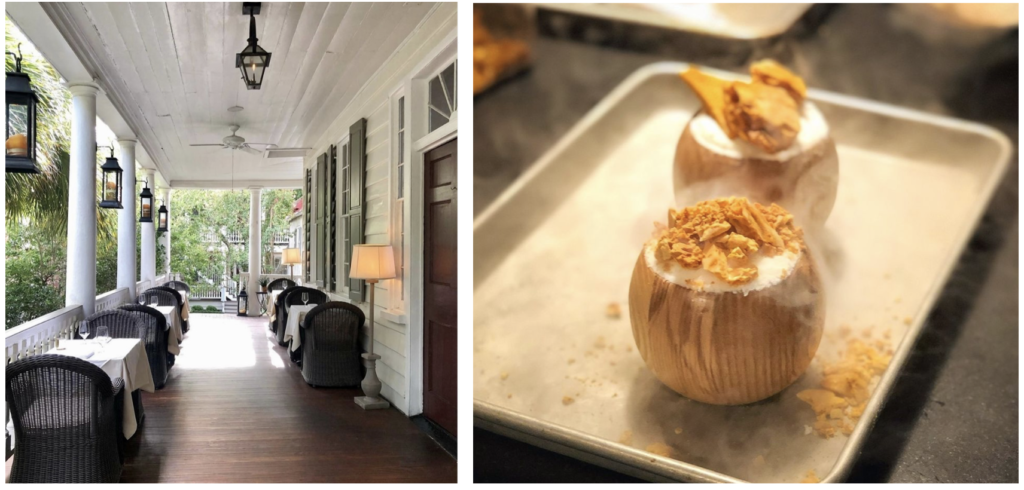
Muse Restaurant is located in the circa 1858 Dr. John Burckmeyer Patrick house, a grand rusticated masonry building in the Italianate style, with arched windows and doors and fine interior wood and plaster work. The house makes a charming restaurant, and it retains original stairs and fireplaces, so diners feel as if they’re visiting a fine private home. The extensive fine dining menu has a Mediterranean flare: mussels, a meze platter with hummus and baba ghanoush; sea bass, veal, eggplant parmesan, and a robust wine selection.

The Peninsula Grill within the Planter’s Inn is a romantic and warm space filled with history. The inn building originally opened as a dry goods and clothing store at the foot of Market Street in 1844, next to stately Market Hall and in the heart of the commercial core of the city. The market area took a downturn in the mid twentieth century, before an extensive revitalization that brought the Charleston Hotel and the more historically minded Planter’s Inn across the street, which opened in 1997.

The Grill has a beautiful courtyard, a full champagne bar, and sumptuous indoor dining rooms. They are known far and wide for the multi-layer “ultimate coconut cake”, and their fine dinner menu. Just a few highlights: lobster “3 way” ravioli, tempura, sauteed, foie gras, she crab soup, and salad firsts; pan seared sea scallops with lobster medallions and whipped potatoes, roasted duck breast with confit leg, steaks for mains; sides such as goat cheese smashed potatoes, or bacon and apple Brussel sprouts; and coconut cake or banana ‘panna cotta’ pudding for dessert.

Tucked in a secluded courtyard behind the grand Wentworth Mansion, an imposing brick Second Empire style mansion-turned-hotel, is Circa 1886, an award winning four diamond restaurant housed in a historic carriage house. The chefs intend the menu to be “a journey through the foodways of South Carolina”, offering several culinary themes on the tasting menu. The African themed choices include butternut squash and peanut soup, a pork duet or tankora spiced guinea hen, and a west African milk tarte for dessert. The Lowcountry seafood theme has shrimp and rice grits, sea scallops, and a spiced pear bake or Huguenot torte. An expert sommelier selects the best parings, and a full bar offers fine signature cocktails.
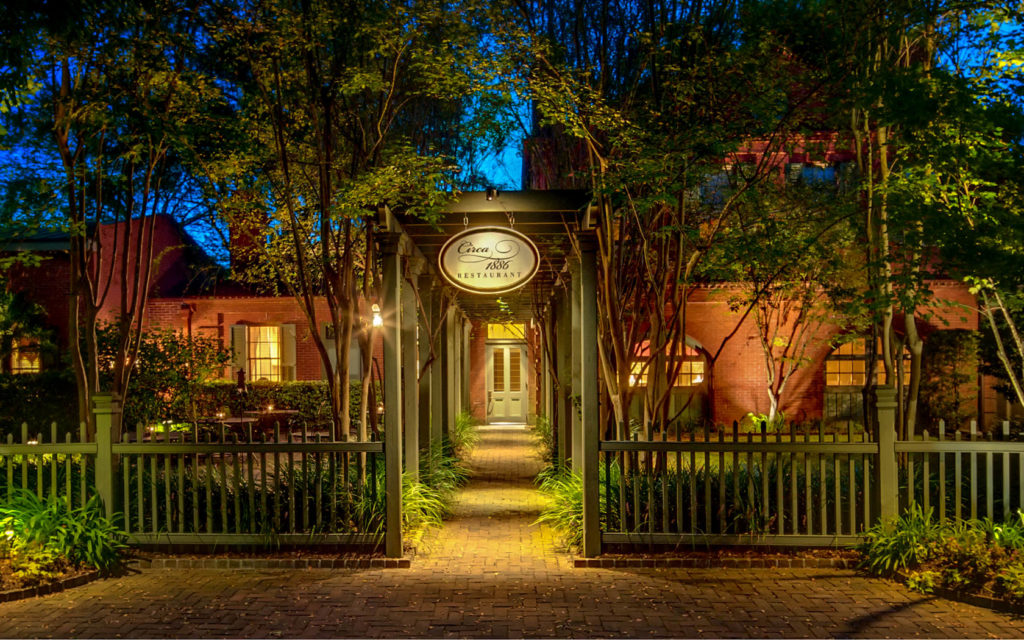
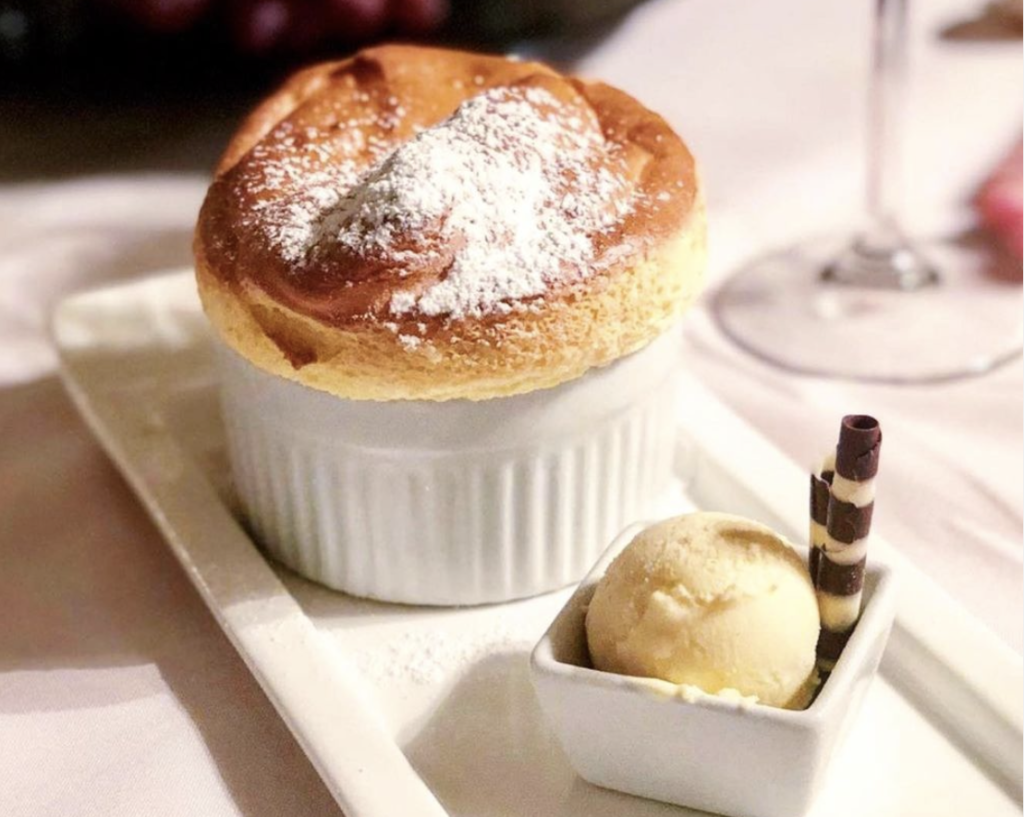
Situated in an antebellum outbuilding and a large Victorian house with porches facing onto Queen Street, Husk has become a favorite special occasion destination for diners who enjoy a creative take on southern classics. The 1893 Graham House was an art gallery and studio for the Gibbes Museum of Art for decades, before Husk renovated the space into an award-winning restaurant in 2010. The menu changes nightly to make use of the freshest seasonal ingredients and keep diners coming back to try new things. A recent menu included hearth baked skillet cornbread with bacon crumble, cornmeal fried catfish with summer squash, and yellowtail snapper with sea island peas.
A sample brunch boasted pecan hand pie with maple glaze or a hearth-baked potato hash with sushitos, collards and poached egg.
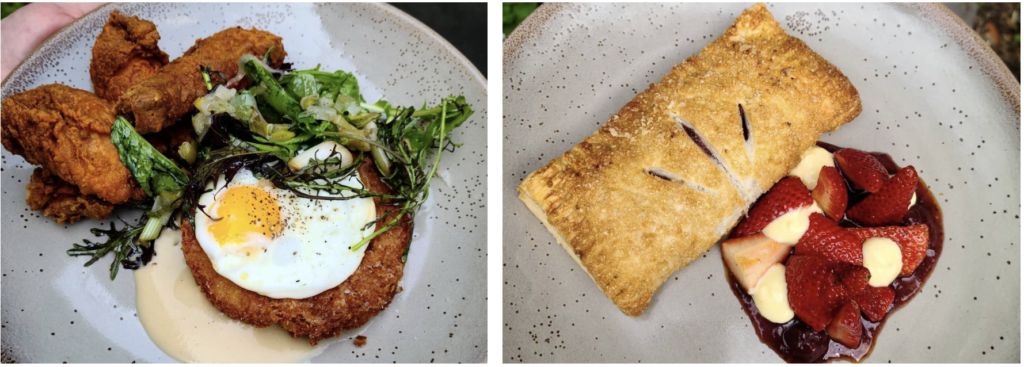
For the steak connoisseur, Hall’s Chophouse is an absolute must. The downtown Charleston location on upper King Street (conceived by the family who brought us High Cotton) has become so popular that the group opened a second location, Hall’s Nexton in Summerville, which recently celebrated its two-year anniversary. The King Street flagship location is popular with young professionals for its delicious bar menu and happy hour drinks post-work. Hall’s offers fine steaks with sauce and preparation options (Oscar style, with lobster, topped with mushrooms and onions and paired with bearnaise, a house Worcestershire, red wine bordelaise, or the house steak sauce), chilled seafood starters, quail, tuna, and salad options for lighter fare. The bar menu includes the Hall’s burger with parmesan truffle fires, a steak martini with whipped potatoes, and salmon salad.

Beloved Mount Pleasant favorite the Post House Inn and Restaurant recently reopened after an extensive renovation, delighting diners with a return to their classic dishes and a bevy of new offerings. They describe themselves as “a coastal tavern and inn offering seasonal fare, classic cocktails, seven cozy hotel rooms, and a bit of salty air. Situated in the heart of the Old Village, Post House is a home away from home for staycationers and travelers alike.” The Post House’s historic shopfront (constructed in 1896) has large windows that flood natural light into the dining room, where the cuisine has a distinct southern flare made with freshest local ingredients from heirloom suppliers: Anson Mills cornbread, southern Panzanella; fish cassoulet, butterbean or beef burgers, heritage farm pork with sweet potato and Carolina apple, fish and Tarvin shrimp curry; oatmeal raisin cookie, buttermilk pie, or flourless chocolate torte.

Topsail in Mount Pleasant brings an exotic flare to fresh local ingredients; chef Brian Appelt spent years cooking at fine dining restaurants in Costa Rice before arriving in Charleston. The menu includes lots of surf, turf, and even vegetarian options: Lobster and crab salad, arugula salad with goat cheese, almonds and balsamic glaze; lobster deviled eggs, shrimp cocktail; flounder, whole market fish, blackened tuna, a nightly vegetarian dish; jasmine rice, grilled asparagus, gruyere grits.
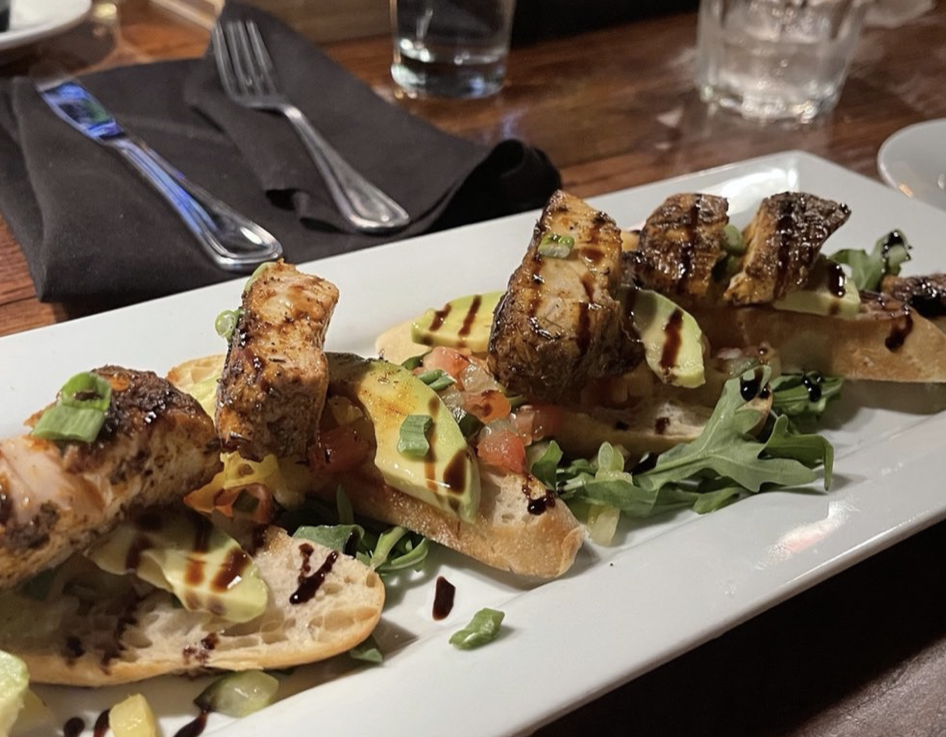
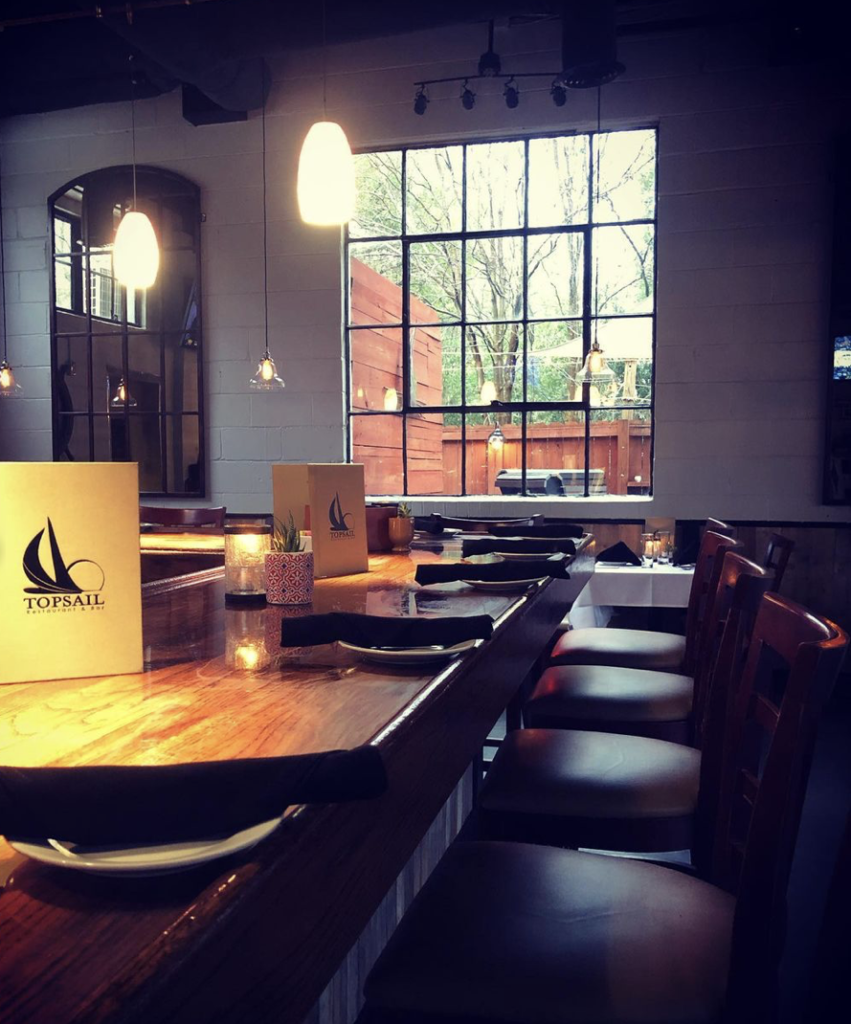
Sources:
- “King Street Renaissance.” Charleston News and Courier. 10 August 1895.
- Property files, 82 Society Street. Historic Charleston Foundation.
- Jonathan Poston. Buildings of Charleston. Columbia: University of South Carolina Press, 1996.
- Historic newspaper articles, Charleston News and Courier.
- Elsa McDowell. “Does anyone eat at home these days?” Post and Courier. 4 March 1997.
- “Get schooled in Charleston’s fine dining history.” Charleston City Paper. 4 August 2010.
- Lowcountry Digital History Iniative. “Nat Fuller’s Feast.” http://ldhi.library.cofc.edu/neatline/show/nat-fuller-map#records/868
- David Shields. Southern Provisions: The Creation and Revival of a Cuisine. Chicago: University of Chicago Press, 2015.
- https://topsailmtpleasant.com/menu
- https://www.theposthouseinn.com
- https://www.charlestonmuse.com
- https://zerorestaurantcharleston.com
- https://www.hallschophouse.com
- https://www.peninsulagrill.com
- https://www.circa1886.com/circa-1886
- https://huskrestaurant.com
- https://www.circa1886.com/circa-1886


